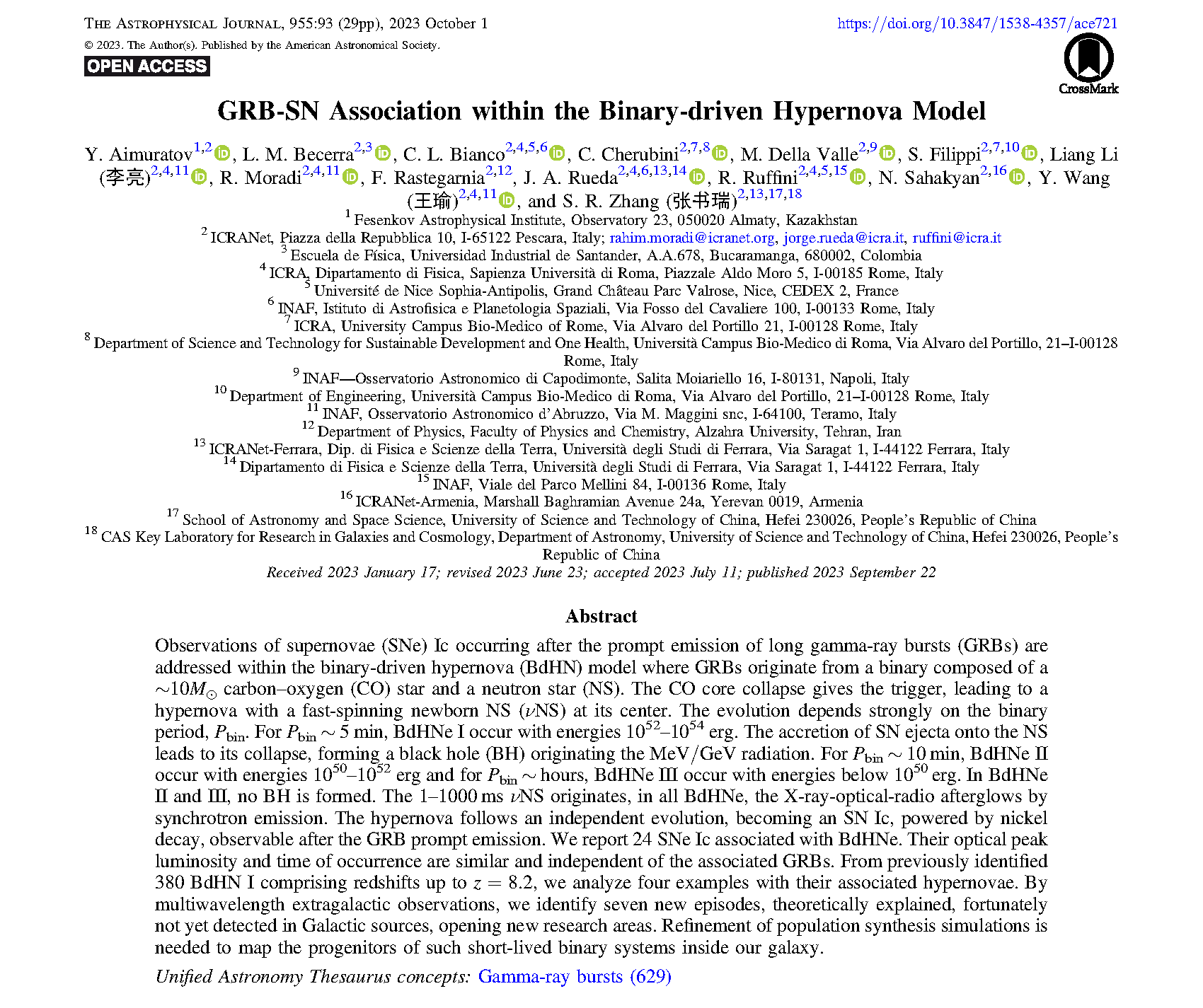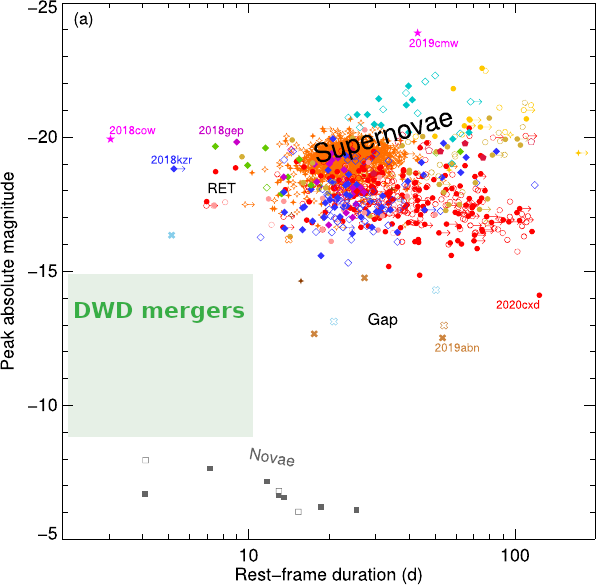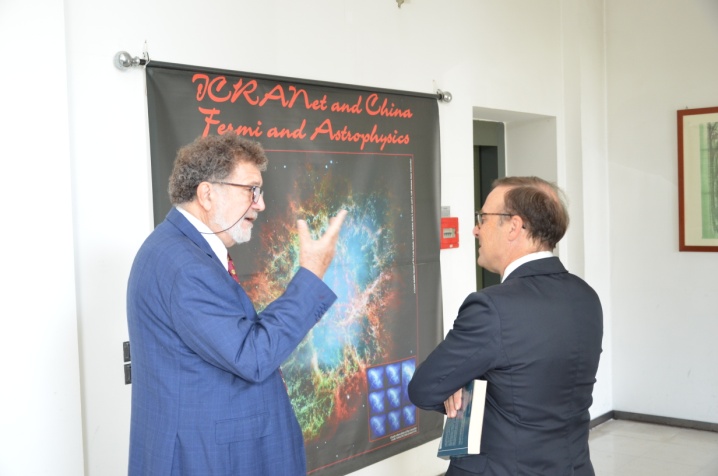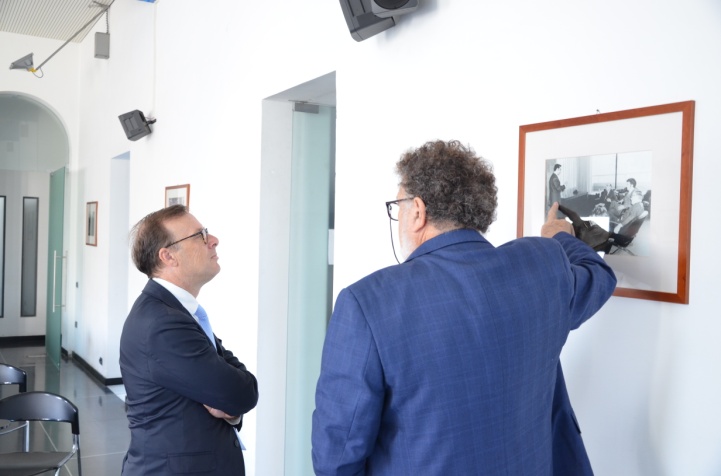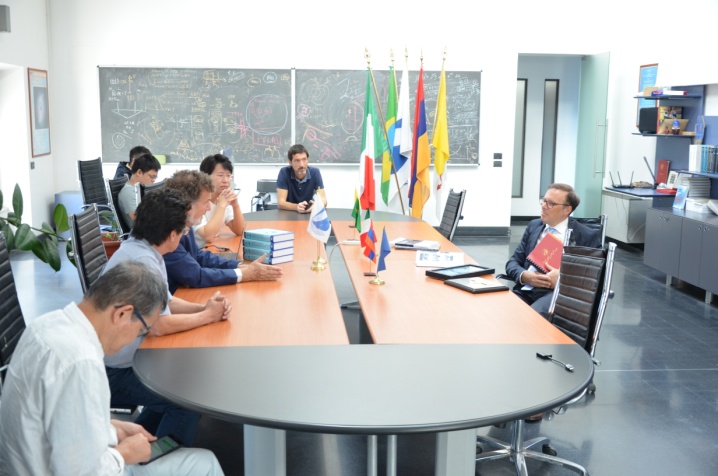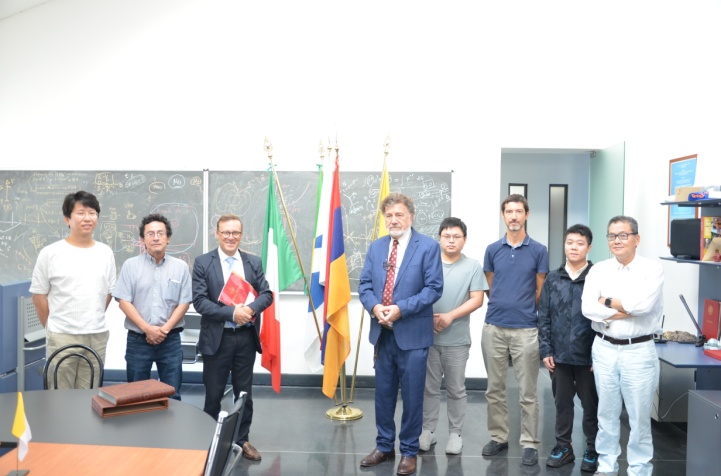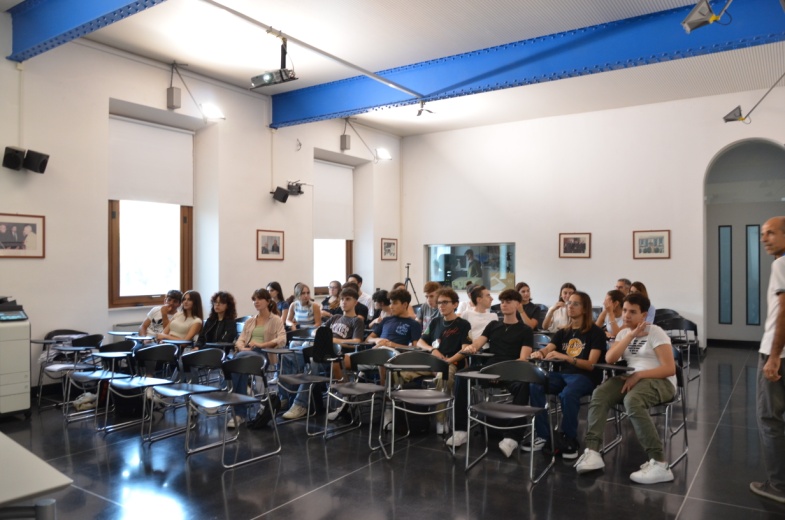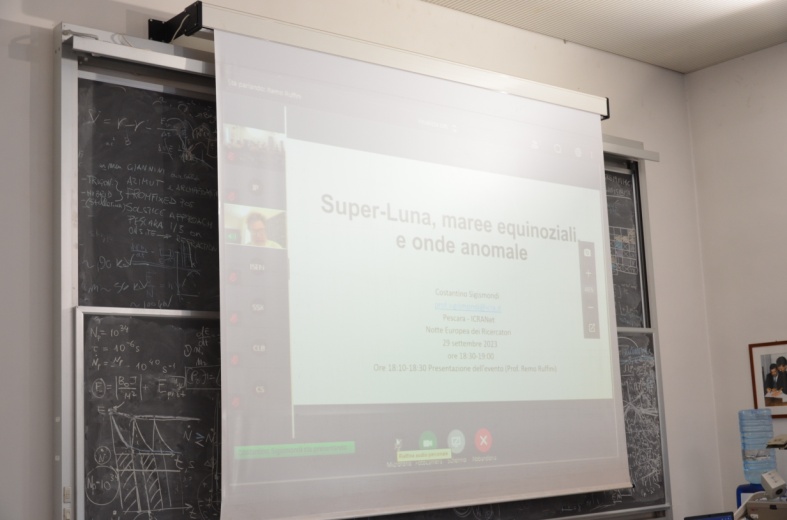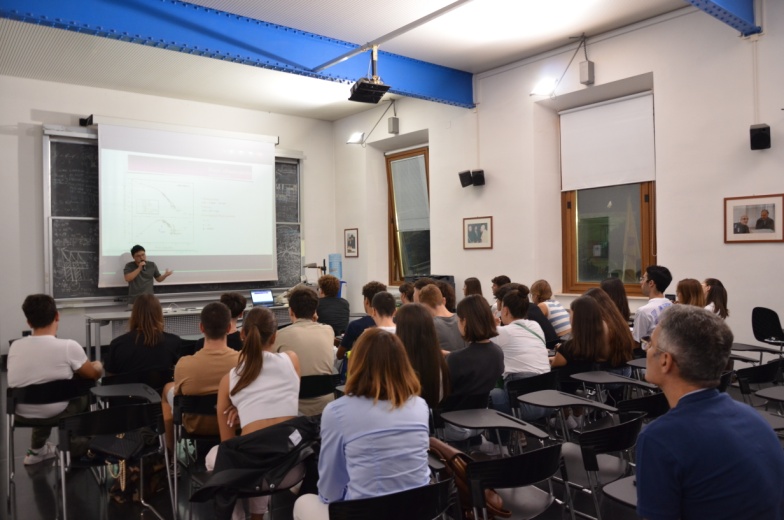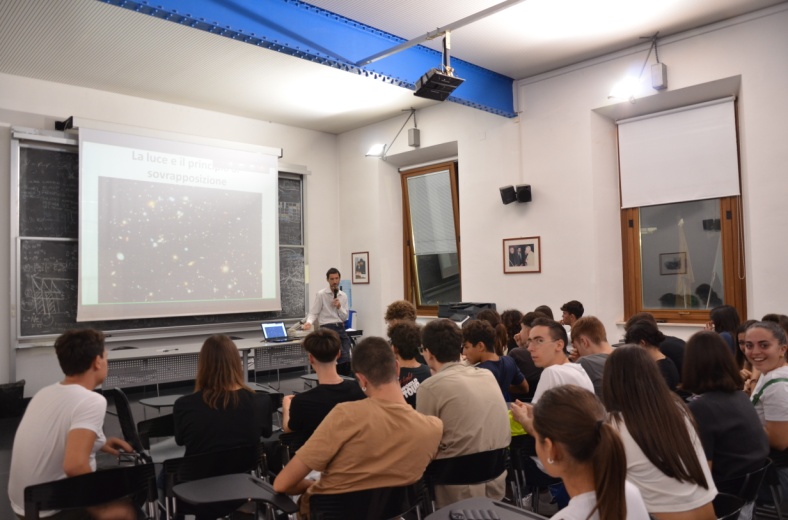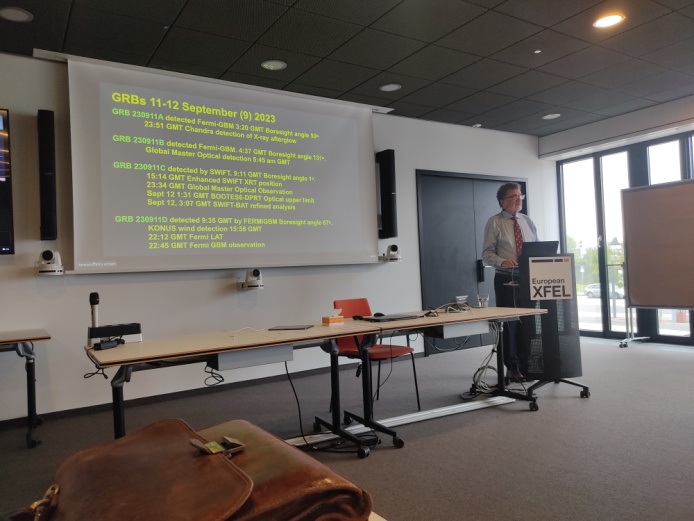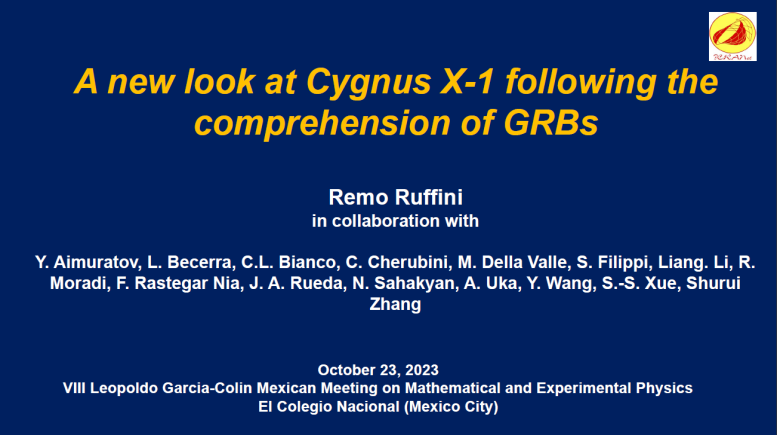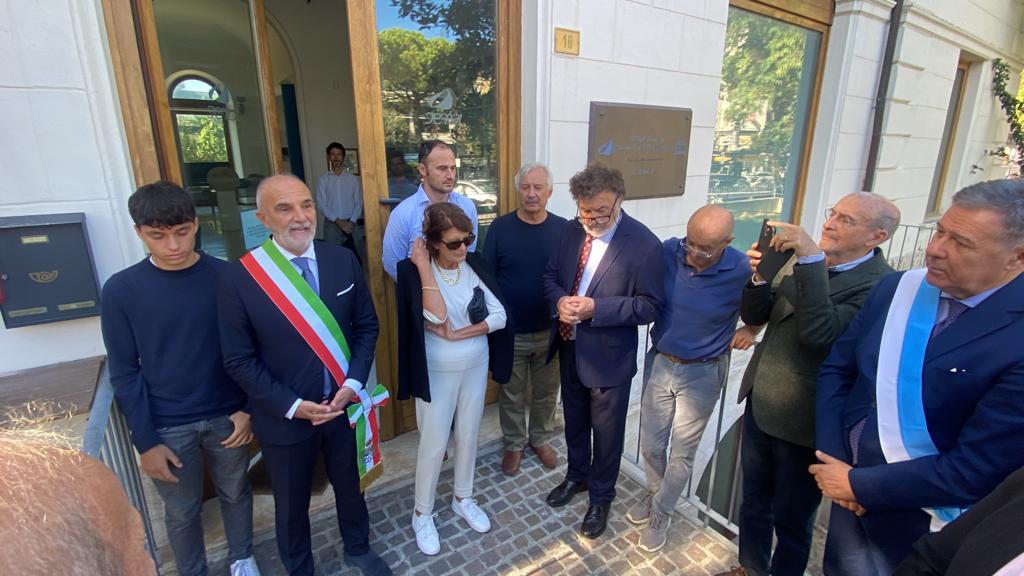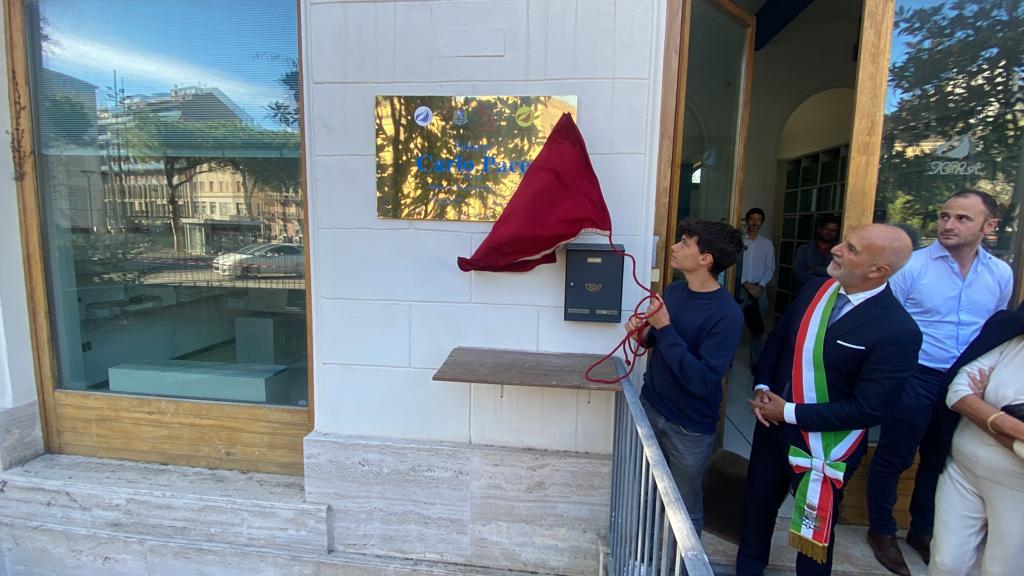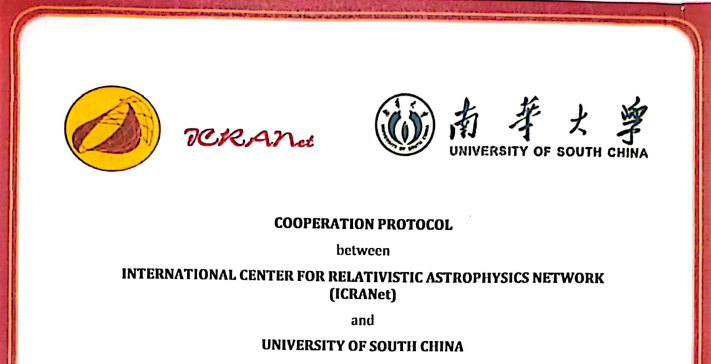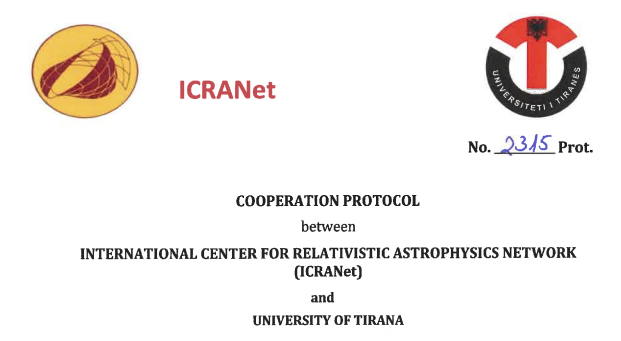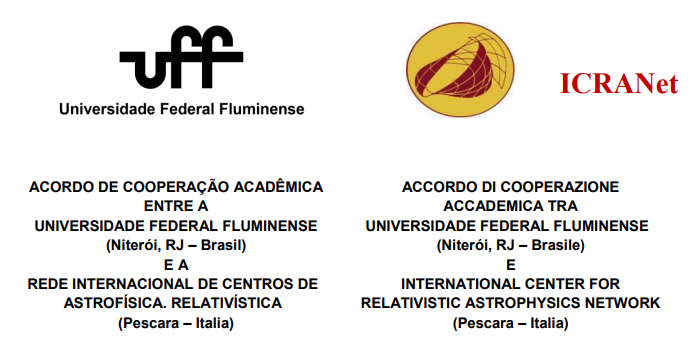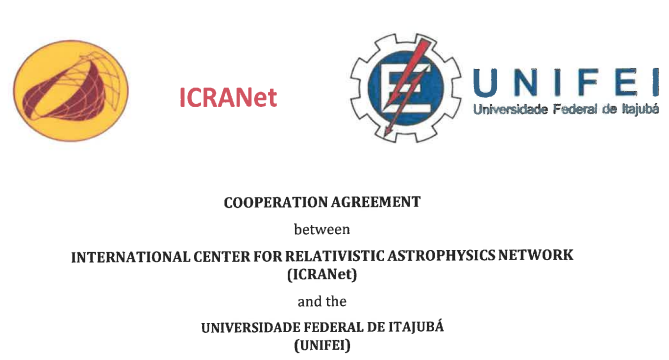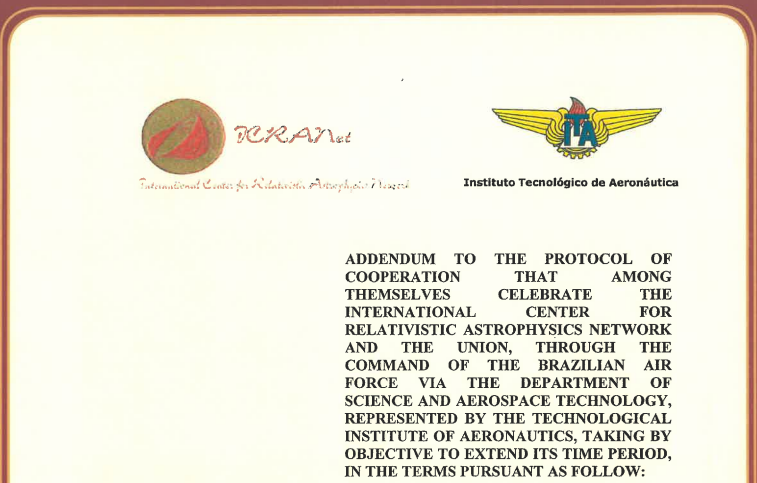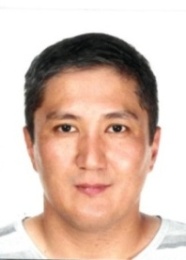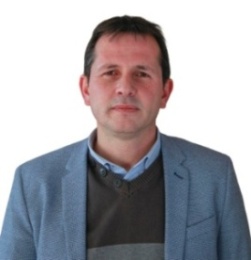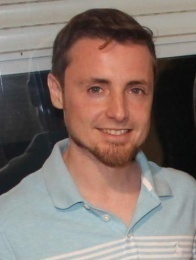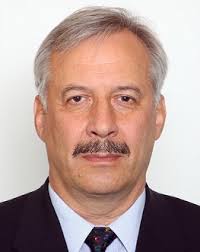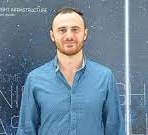

| Newsletter French September/October 2023 |

|

|



ICRANet Newsletter
2014 -
2015 -
2016
2017 - 2018 - 2019 2020 - 2021 - 2022 2023 February/March - April/May - June-July-August - September/October
Bulletin ICRANet
Septembre/Octobre 2023
RÉSUMÉ
1. L’article “GRB-SN Association within the Binary-Driven Hypernova Model” par Aimuratov at al., publié en ApJ, 955 (2023) 93 le 1 Octobre 2023 2.Communiqué de presse ICRA-ICRANet “A New Predicted Class of Astrophysical Sources: White Dwarf Binary Mergers Poised for Discovery at The Vera Rubin Observatory”, 2 Novembre 2023 3.GCN ICRANet 34779, 28 Septembre 2023 4. Visite de S.E. Giancarlo Di Vincenzo, Préfet de Pescara, auprès du centre ICRANet de Pescara, 12 Octobre 2023 5. La nuit européenne des chercheurs, 29 Septembre 2023 6.Séminaire scientifique European XFEL du Prof. Ruffini, XFEL Hambourg (Allemagne), 12 Septembre 2023 7. Participation d’ICRANet au VIII Leopoldo Garcia-Colin Mexican Meeting on Mathematical and Experimental Physics, 23-27 Octobre 2023, Mexico (Mexique) 8. Dédicace du bâtiment d’ICRANet à Carlo Pace, Pescara (Italie),28 Octobre 2023 9. Nouveau protocole de coopération ICRANet - University of South China, 28 Septembre 2023 10. Renouvellement de 5 accords de collaboration entre l’ICRANet et l’Académie nationale des Sciences de Belarus (NASB), l’Université de Tirana, l’Universidade Federal Fluminense (UFF), l’Universidade Federal de Itajubà (UNIFEI) et l’Instituto Tecnológico de Aeronáutica (ITA) 11. Visites scientifiques auprès d’ICRANet 12. Publications récentes
1.L’article “GRB-SN Association within the Binary-Driven Hypernova Model” par Aimuratov at al., publié en ApJ, 955 (2023) 93 le 1 Octobre 2023
Article de référence:
Y. Aimuratov, L. M. Becerra, C.L. Bianco, C. Cherubini, M. Della Valle, S. Filippi, Liang Li, R. Moradi, F. Rastegarnia, J. A. Rueda, R. Ruffini, N. Sahakyan, Y. Wang, S. R. Zhang, GRB-SN Association within the Binary-Driven Hypernova Model, ApJ, 955 (2023) 93; DOI: https://doi.org/10.3847/1538-4357/ace721
Pour plus de détails, veuillez consulter le numéro précédent du bulletin ICRANet.
2.Communiqé de presse ICRA-ICRANet “A New Predicted Class of Astrophysical Sources: White Dwarf Binary Mergers Poised for Discovery at The Vera Rubin Observatory”, 2 Novembre 2023
Astrophysicists are about to take an important step forward: recent research that will be published in The Astrophysical Journal anticipates that the Vera Rubin Observatory (VRO), scheduled to release the first public data in 2025, will be able to observe a new type of astrophysical source: the merger of binary systems of white dwarfs. The research was conducted by an Italian team from the International Center for Relativistic Astrophysics Network(ICRANet) and the University of Ferrara, associates of the National Institute of Astrophysics (INAF), together with Brazilian colleagues from the Instituto Nacional de Pesquisas Espaciais (INPE), the Universidade Federal do Espìrito Santo (UFES), and the Universidade Tecnologica Federal do Paranà (UTFPR).
In some cases, it is believed that mergers of binary white dwarfs occur in a completely destructive way, producing a supernova explosion called Ia. These supernovae are regularly observed from distant galaxies. However, many of these mergers can follow a different fate: they form a massive white dwarf with an associated transient source less luminous than a supernova and with a more rapid evolution. Although they are estimated to be very abundant, these less catastrophic mergers have escaped any observation by current telescopes, as they are not sufficiently sensitive. The research predicts that the emission produced by mergers of binary systems of white dwarfs, in wavelengths from infrared to ultraviolet, will be observed by VRO with an astonishing frequency, up to a thousand per year!
The light source emitted by the material expelled at high speed (about 1000 km/s) with temperatures of 100thousand degrees for a few hours, is 10 to 100 million times brighter than the Sun. However, the rapid expansion causes the material to cool quickly, making their identification elusive. The most exciting result of the research is that, by putting together the expected population of these mergers and their emission characteristics, the researchers estimated that VRO, equipped with cutting-edge instrumentation and a wide field of view, is ready to discover these mergers in great abundance. Observing these stellar mergers will allow unprecedented insights into their birth and evolution if the predictions are confirmed. The authors say such observations will profoundly impact our knowledge of astrophysical phenomena linking massive white dwarfs to the formation of neutron stars. They will also provide crucial information on the possible generation of Type Ia supernovae from binary white dwarf mergers.
To the various types of transient sources that VRO is preparing to discover in abundance, we add the merger of binary systems of white dwarfs, whose observations will offer a revolutionary contribution to the knowledge of the life and evolution of these types of stars, including the genesis of ultraintense magnetic fields.
contact:
Prof. Jorge A. Rueda ICRANet Faculty E-mail: jorge.rueda@icra.it
Article de référence: On the optical transients from double white-dwarf mergers
Authors: M.F. Sousa, J.G. Coelho, J.C.N. de Araujo, C. Guidorzi, J.A. Rueda à paraitre sur The Astrophysical Journal Préprint: https://arxiv.org/abs/2310.06655
Pour le communiqué de presse sur le site d’ICRANet: http://www.icranet.org/index.php?option=com_content&task=view&id=1032&Itemid=920
En Italie:
En Brazil:
Subject: transient AT2023sva: A Binary Driven Hypernova with a possible associated supernova
Date:2023-09-28T16:05:44Z From: Remo Ruffini at ICRA Via:Web form
R. Ruffini, Y. Aimuratov, L. Becerra, C.L. Bianco, C. Cherubini, S. Filippi, Liang Li, R. Moradi, F. Rastegar Nia, J.A. Rueda, N. Sahakyan, Y. Wang, S.S. Xue, S.R. Zhang, on behalf of the ICRANet team, report:
Following the BdHN classification [Aimuratov, et al., ApJ 955 (2023) 93] and the determination of the redshift z=2.2 of transient AT2023sva(de Ugarte Postigo, et al., GCN34740), from the energetics evaluated by Liang Li (2023) from Fermi GBM data in (2.15+/-0.13)x10^{52} erg (see attached figure), we conclude that the source is a BdHN II (GRB230916A).
We Propose to look with the James Webb Space Telescope the appearance of the associated supernova (SN) on October 31 (+/-1 day), in order to extend the GRB-SN connection in the range 1
4.Visite de S.E. Giancarlo Di Vincenzo, Préfet de Pescara, auprès du centre ICRANet de Pescara, 12 Octobre 2023
Le 12 Octobre 2023, le Préfet de Pescara, S.E. Giancarlo Di Vincenzo, a visité le centre ICRANet à Pescara. Le Prof. Remo Ruffini, Directeur d’ICRANet, lui a montré et présenté le centre ainsi que sa bibliothèque et les précieux livres, photos et documents qui y sont rassemblés. Le professeur Ruffini a également illustré les activités actuelles d’ICRANet, les principaux sujets de recherche et les résultats obtenus. Les projets actuels mis en œuvre par le centre ICRANet de Pescara ont également été présentés et discutés. Le rôle important joué par l’ICRANet dans la promotion quotidienne des échanges scientifiques dans le monde et l'établissement d'accords avec les principales universités et instituts de recherche dans le monde a également été souligné et discuté.
Le Dr Di Vincenzo a également rencontré le personnel, la faculté et les scientifiques de l'ICRANet, qui lui ont parlé de leur important travail et de leur expérience ici à Pescara.
Comme chaque année, ICRANet a organisé un événement à l'occasion de la Nuit européenne des chercheurs, afin de créer un moment privilégié de discussion entre citoyens et chercheurs. Cet événement a attiré beaucoup plusieurs participants, comme chaque année, et a offert aux visiteurs une occasion unique de participer à des activités scientifiques visant à mettre en évidence à la fois la fascination de la recherche en tant que carrière et son impact sociétal significatif. Le meeting s’est tenu au centre ICRANet de Pescara, à Nice et en ligne, le vendredi 29 Septembre 2023, de 16 à 22 h.
Après les allocutions de bienvenue par le Prof. Ruffini, Directeur d’ICRANet, le meeting a débuté auprès le siège d’ICRANet à Villa Ratti, Nice (France) – qui a été diffusée dans le monde entier - où le Prof. Ruffini a présenté son exposé “Les trous noirs dans l’Univers”, suivi par celui du Prof. Joseph Kouneiher (Président du Projet Archimède E.C.A.) titré “Les Rencontres de Villa Ratti”.
Peu après, le meeting s’est déplacé auprès du centre ICRANet de Pescara (et a été diffusée dans le monde entier), où ont participé les élèves de deux classes du lycée scientifique Galileo Galilei de Pescara, sous la supervision de leur tuteur, la Prof. Tiziana Pompa. Costantino Sigismondi (collaborateur d’ICRANet et ITIS Galileo Ferraris, Rome) a présenté un exposé titré “Super-Lune, marées équinoxiales et ondes scélérates”, suivi par le Dr Liang Li (Professeur de la Faculté ICRANet) qui a présenté son exposé “La source d'énergie du GRB 230916” et par le Prof. Gregory Vereshchagin (Professeur de la ICRANet) qui a présenté son exposé “Création électron-positron et blocage de Pauli”.
De 18 h à 21 h, le centre ICRANet Hq de Pescara a été ouvert aux citoyens pour des visites guidées, où les membres de la Faculté ICRANet ont répondu aux questions des visiteurs.
A 21 h, la réunion s’est poursuivie avec la diffusion de la conférence du Prof. Jorge A. Rueda Hernandez (Professeur de la Faculté d’ICRANet et Université de Ferrara) titrée “Univers Invisible” dans le cadre du projet “Universo a km0”. Cette conférence s'est tenue à Marano di Valpolicella (Italie) et a été suivie par l'observation de Saturne avec les télescopes.
Les remarques finales ont été présentées par le Prof. Ruffini, qui a remercié tous les participants de s'être joints à cet événement.
Pour consulter le program du meeting:http://www.icranet.org/documents/program_ruropean_researchers_night_2023.pdf
6.Séminaire scientifique European XFEL du Prof. Ruffini, XFEL Hambourg (Allemagne), 12 Septembre 2023
Le 12 Septembre 2023, le Prof. Ruffini, Directeur d’ICRANet, accompagné par le Prof. Arban Uka (Epoka University – Albanie), a été invité à présenter un séminaire au centre XFEL à Hambourg (Allemagne). Ce séminaire a été inséré dans la série des “European XFEL Science Seminars”, qui se tiennent régulièrement à Hambourg. Le Prof. Ruffini a donné une présentation titrée “GRB220101A the most powerful GRB with seven BdHN Episodes observed”; voici ci-dessous l’abstract:
A long GRB that occurred at 2022-01-01 05:11:13 (UT), was triggered by multiple satellites, including Swift (Tohuvavohu et al. 2022), Fermi (Arimoto et al. 2022), AGILE (Ursi et al. 2022), and Konus-Wind (Tsvetkova et al. 2022). The optical observation by Xinglong -2.16 m telescope (Fu et al. 2022) revealed a broad absorption feature in the spectrum indicating the presence of Lyman alpha absorption, as well as from the absorption lines, the redshift was determined to be z= 4.61, which was confirmed by the Liverpool telescope (Perley 2022) and NOT (Fynbo et al. 2022). The burst exhibited a bright , complex multi-peaked time profile within the first ~ 150 s. An estimated isotropic equivalent energy is of Eiso~4x1054 erg, and a peak luminosity is of Lp~ 9 x 1053 erg s-1, making GRB 220101 A as one of the most luminous GRB ever observed. The fact that it occurs at z=4.6 gives a great opportunity to exploit new perspectives of observations as presented in Bianco et al. 2023. The discovery of a radio source with a mean frequency of 6.0 GHz was reported in Laskar (2022a). This finding aligns with the X-ray position noted in Osborne et al. (2022), as well as the optical positions reported by Tohuvavohu et al. 2022 and Hentunen et al. (2022), along with the mm-band position mentioned in Laskar (2022b). All seven episodes characterizing a BdHN I, as predicted in Ruffini et al. (2022 a,b), have been identified, details are presented in Ruffini et al., (submitted). our attention in this article is to identify the earliest XRT observations made possible by the use of the cosmological redshift of z=4.61 and to obtain an unprecedented accurate description of the rising part and the power-law decay part of the x-ray emission evidencing the transition from a Jacobi ellipsoid into a Mac Laurin spheroid in the description of a new NS originating the afterglow.
À cette occasion, il a visité les centres et laboratoires de XFEL et de DESY, et a également eu la possibilité de rencontrer la Prof. Sakura Pascarelli (Directeur scientifique de XFEL) et la Prof. Beate Heinemann (directeur chargé de la physique des particules à DESY).
Pour l’annonce du séminaire sur le site web de EuXFEL: https://indico.desy.de/event/39848/
7.Participation d’ICRANet au VIII Leopoldo Garcia-Colin Mexican Meeting on Mathematical and Experimental Physics, 23-27 Octobre 2023, Mexico (Mexique)
Le 23 Octobre 2023, le Prof. Ruffini, Directeur d’ICRANet, a été invite à présenter une conférence plénière à l’occasion du VIII Leopoldo Garcia-Colin Mexican Meeting on Mathematical and Experimental Physics, qui s’est tenue à Mexico (Mexique) du 23 au 27 Octobre 2023.
Le lundi 23 Octobre, le Prof. Ruffini a présenté une conférence titrée “A new look at Cygnus X-1 following the comprehension of GRBs-2”; voici ci-dessous l’abstract:
The understanding of Gamma-Ray Bursts (GRBs) has used, as successful models, progenitors binary systems of massive stars of mass up to 18 solar masses. Such progenitors evolve themselves in a supernova (SN) event: the most massive of the binary undergoes an SN, forming a neutron star (NS), which remains bound to the companion less massive binary star companion. The NS induces a co-rotation on the CO core of the companion star, which undergoes a gravitational collapse, leading to an SN creating a new NS (vNS). The SN ejecta accreting onto the companion NS binary leads to the forming of a Black Hole (BH). The newly formed BH and the vNS are the basic components of the most powerful GRBs: 10 examples of CO-core collapse triggering the GRB process will be presented. The BH originates by electrodynamics process to the observed GeV emission, while the fat spinning vNS leads to the observed X-ray, optical, and radio emission of the GRB afterglow. Some preliminary results for the evolution of binary systems composed of masses higher than 18 solar masses connected to Cygnus X-1, here revisited 50 years after I identified it as a BH for the first time at the Sixth Texas Symposium on Relativistic Astrophysics in New York on December 18-22, 1972.
Pour l’enregistrement de la conférence du Prof. Ruffini su la chaîne YouTube d’ICRANet : https://www.youtube.com/watch?v=b00i6iKr5WM
Le bâtiment du siège ICRANet, situé à Piazza della Repubblica 10 à Pescara (Italie), a été consacré au Dr Carlo Pace, ancien Maire de Pescara de 1994 à 2003, décédé accidentellement en 2017. Afin de célébrer cet événement, une cérémonie officielle a été organisée par la municipalité de Pescara le samedi 28 Octobre 2023.
D'éminentes autorités locales et nationales ont participé à cette cérémonie, à savoir le Maire de Pescara Carlo Masci, le Président du Conseil régional Lorenzo Sospiri, le Président du Conseil municipal Marcello Antonelli, le député italien Nazario Pagano, de nombreux conseillers et conseillers municipaux et le Vice-recteur de l'Université de Chieti-Pescara Gabriele D'Annunzio Tonio Di Battista. La cérémonie s'est déroulée à la présence de la famille de Carlo Pace, des autorités civiles et militaires, des représentants du monde académique et culturel ainsi que d’une délégation d'étudiants de l'Institut technique Tito Acerbo de Pescara.
Dans les premières années du 2000, Carlo Pace a eu l'idée de transformer l'ancienne gare de Pescara en un brillant centre de recherche, à savoir ICRANet, car il voulait projeter Pescara, la ville qu'il aimait, dans la connaissance du monde et des étoiles, qui regarde vers l'avenir. Comme bien exprimé par le Maire Masci, Carlo Pace avait une grande vision, de grandes compétences et de l'honnêteté. La municipalité de Pescara a fortement soutenu la dédicace de l'édifice qui lui est consacré, afin de commémorer une personnalité de premier plan de la vie administrative de la ville, qui a accompli son travail avec abnégation, en réalisant une brillante œuvre culturelle et humaine et en devenant un point de référence irremplaçable pour les administrateurs.
Le Prof. Ruffini, Directeur d’ICRANet, a exprimé l’espoir que les institutions locales et l’Université soutiendraient ICRANet, au nom de Carlo Pace qui croyait tant en cette réalité. Il a souhaité que ces espaces deviennent de plus en plus des lieux de science et de recherche pour un nombre croissant de doctorants, comme ceux formés par ICRANet.
Pour les communiqués de presse (en italien):
Pour la vidéo (en italien):
Le 9 Septembre 2023 l’ICRANet a signé un nouveau protocole de coopération avec l’University of South China (USC) en Chine. Le protocole de coopération a été signé par le Prof. Dr. Zhang Zhuohua (Président de l’USC), le Prof. Dr. Wenbin Lin (Doyen École de mathématiques et de physique USC), le Prof. Remo Ruffini (Directeur d’ICRANet) et le Prof. Shesheng Xue (Professeur de la Faculté d’ICRANet).
La durée de l’accord sera de cinq ans et les principales activités conjointes qui seront développées dans ce cadre seront: l'échange institutionnel d'étudiants diplômés, d'étudiants de troisième cycle, de chercheurs et de membres du corps enseignant, le développement d'activités d'enseignement et/ou de recherche liées aux domaines d'expertise et d'intérêt des deux organisations, l'organisation de symposiums, de séminaires, de conférences et de cours de courte durée, la promotion et le support d'événements et d'activités technico-scientifiques et culturels ouverts au public; le développement d'opportunités pour former des enseignants et des chercheurs universitaires, l'organisation de cours et d'activités de formation ainsi que le développement de domaines de recherche interinstitutionnels associés à des programmes locaux d'études supérieures; la promotion de publications conjointes; la mise en œuvre d'activités à orientation sociale par le biais de l'extension universitaire; l'échange d'informations concernant les activités d'enseignement et de recherche dans les deux institutions ainsi que les demandes de subventions internationales pour promouvoir des projets de recherche conjoints ou mettre en œuvre des programmes d'échange de mobilité.
Pour le texte de l’accord: http://www.icranet.org/index.php?option=com_content&task=view&id=1500
10.Renouvellement de 5 accords de collaboration entre l’ICRANet et l’Académie nationale des Sciences de Belarus (NASB), l’Université de Tirana, l’Universidade Federal Fluminense (UFF), l’Universidade Federal de Itajubà (UNIFEI) et l’Instituto Tecnológico de Aeronáutica (ITA)
Renouvellement de l’accord de coopération entre l’ICRANet et l’Académie nationale des Sciences de Belarus (NASB)
Le 7 Septembre 2023, l’accord de coopération entre l’ICRANet et l’Académie nationale des Sciences de Belarus (NASB) a été renouvelé. Ce renouvellement a été signé par l’Académicien Vladimir G. Gusakov (Président du Présidium de la NASB), par le Prof. Alexander Shumilin (Président du comité d'État pour la science et la technologie de la République de Belarus), par le Prof. Remo Ruffini (Directeur d’ICRANet) et par le Prof. Gregory Vereshchagin (Professeur de la Faculté d’ICRANet). Cet accord sera valable pour une durée supplémentaire de 5 ans et les principales activités conjointes qui seront développées dans ce cadre seront: la réalisation de recherches conjointes sur des questions scientifiques d’intérêt pour les deux parties, l'organisation de manifestations scientifiques et scientifiques-pratiques bilatérales, l'échange d'expériences entre les employés impliqués dans la recherche et l'enseignement, la publication de travaux scientifiques conjoints dans des revues internationales ainsi que l'échange de publications, de matériel d'enseignement et de cours magistraux.
Pour le texte de l’accord: http://www.icranet.org/index.php?option=com_content&task=view&id=1050
Renouvellement du protocole de coopération entre l’ICRANet et l’Université de Tirana (Albanie)
Le 14 Septembre 2023, le protocole de coopération entre l’ICRANet et l’Université de Tirana (Albanie) a été renouvelé. Ce renouvellement a été signé par le Prof. Dr Artan Hoxha (Recteur de l’Université de Tirana), par le Prof. Mimoza Hafizi (Université de Tirana), par le Prof. Remo Ruffini (Directeur d’ICRANet) et par le Prof. Jorge A. Rueda H. (Professeur de la Faculté d’ICRANet). Cet accord sera valable pour une durée supplémentaire de 5 ans et les principales activités conjointes qui seront développées dans ce cadre seront: des recherches conjointes sur des questions scientifiques d’intérêt pour les deux parties, l'organisation d'événements scientifiques et scientifiques-pratiques bilatéraux, l'échange d'expériences entre les employés impliqués dans la recherche et l'enseignement, la publication de travaux scientifiques conjoints dans des revues internationales ainsi que l'échange de publications, de matériel d'enseignement et de cours magistraux.
Pour le texte de l’accord: http://www.icranet.org/index.php?option=com_content&task=view&id=1187
Renouvellement de l’accord de coopération académique entre l’ICRANet et l’Universidade Federal Fluminense (UFF)
On September 20, 2023, the academic cooperation agreement between ICRANet and the Universidade Federal Fluminense – UFF (Brazil) has been renewed. The renewal was signed by Prof. Antonio Claudio Lucas da Nobrega (Rector of UFF) and by Prof. Remo Ruffini (Director of ICRANet).This agreement will be valid for additional5 years and the main joint activities to be developed under its framework include: the conduction of joint research on scientific issues of interest to both parties, the organization of bilateral scientific and scientific-practical events, the exchange of experience between employees involved in research and teaching, the publication of joint scientific works in international journals as well as the exchange of publications, teaching materials and lecture courses.
For the text of the agreement: http://www.icranet.org/index.php?option=com_content&task=view&id=1024
Renewal of the cooperation agreement between ICRANet and the Universidade Federal de Itajubà (UNIFEI)
Le 20 Septembre 2023, l’accord de coopération académique entre l’ICRANet et l’Universidade Federal Fluminense – UFF (Brésil) a été renouvelé. Le renouvellement a été signé par le Prof. Antonio Claudio Lucas da Nobrega (Recteur de la UFF) et par le Prof. Remo Ruffini (Directeur d’ICRANet). Cet accord sera valable pour une durée supplémentaire de 5 ans et les principales activités conjointes qui seront développées dans ce cadre seront: des recherches conjointes sur des questions scientifiques d’intérêt pour les deux parties, l'organisation d'événements scientifiques et scientifiques-pratiques bilatéraux, l'échange d'expériences entre les employés impliqués dans la recherche et l'enseignement, la publication de travaux scientifiques conjoints dans des revues internationales ainsi que l'échange de publications, de matériel d'enseignement et de cours magistraux.
Pour le texte de l’accord: http://www.icranet.org/index.php?option=com_content&task=view&id=1021
Renouvellement de l’accord de coopération entre l’ICRANet et l’Universidade Federal de Itajubà (UNIFEI)
Le 24 Octobre 2023, l’accord de coopération entre l’ICRANet et l’Universidade Federal de Itajubà - UNIFEI (Brésil) a été renouvelé. Le renouvellement a été signé par le Prof. Dr. Tales Cleber Pimenta (Directeur du bureau des relations internationales UNIFEI), par le Prof. Remo Ruffini (Directeur d’ICRANet) et par le Prof. Jorge A. Rueda H. (Professeur de la Faculté d’ICRANet). Cet accord sera valable pour une durée supplémentaire de 5 ans et les principales activités conjointes qui seront développées dans ce cadre seront: des recherches conjointes sur des questions scientifiques d’intérêt pour les deux parties, l'organisation d'événements scientifiques et scientifiques-pratiques bilatéraux, l'échange d'expériences entre les employés impliqués dans la recherche et l'enseignement, la publication de travaux scientifiques conjoints dans des revues internationales ainsi que l'échange de publications, de matériel d'enseignement et de cours magistraux.
Pour le texte de l’accord: http://www.icranet.org/index.php?option=com_content&task=view&id=1014
11.Visites scientifiques auprès d’ICRANet
Pendant leur visite, ils ont eu l'opportunité de discuter de leur travaux de recherché et d'avoir des intéressants échanges d'opinion avec les autres chercheurs ICRANet de toutes les parties du monde.
Y. Aimuratov, L. M. Becerra, C.L. Bianco, C. Cherubini, M. Della Valle, S. Filippi, Liang Li, R. Moradi, F. Rastegarnia, J. A. Rueda, R. Ruffini, N. Sahakyan, Y. Wang, S. R. Zhang, GRB-SN Association within the Binary-Driven Hypernova Model, published in The Astrophysical Journal 955:93 (29pp), on October 1, 2023.
Observations of supernovae (SNe) Ic occurring after the prompt emission of long gamma-ray bursts (GRBs) are addressed within the binary-driven hypernova (BdHN) model where GRBs originate from a binary composed of a ∼10M⊙carbon–oxygen (CO) star and a neutron star (NS). The CO core collapse gives the trigger, leading to a hypernova with a fast-spinning newborn NS (νNS) at its center. The evolution depends strongly on the binary period, Pbin. For Pbin∼ 5 min, BdHNe I occur with energies 1052–1054 erg. The accretion of SN ejecta onto the NS leads to its collapse, forming a black hole (BH) originating the MeV/GeV radiation. For Pbin∼ 10 min, BdHNe II occur with energies 1050–1052 erg and for Pbin∼ hours, BdHNe III occur with energies below 1050 erg. In BdHNe II and III, no BH is formed. The 1–1000 ms νNS originates, in all BdHNe, the X-ray-optical-radio afterglows by synchrotron emission. The hypernova follows an independent evolution, becoming an SN Ic, powered by nickel decay, observable after the GRB prompt emission. We report 24 SNe Ic associated with BdHNe. Their optical peak luminosity and time of occurrence are similar and independent of the associated GRBs. From previously identified 380 BdHN I comprising redshifts up to z = 8.2, we analyze four examples with their associated hypernovae. By multiwavelength extragalactic observations, we identify seven new episodes, theoretically explained, fortunately not yet detected in Galactic sources, opening new research areas. Refinement of population synthesis simulations is needed to map the progenitors of such short-lived binary systems inside our galaxy.
Rodríguez, J. F.; Rueda, J. A.; Ruffini, R.; Zuluaga, J. I.; Blanco-Iglesias, J. M.; Lorén-Aguilar, P., Chirping compact stars: gravitational radiation and detection degeneracy with binaries, published in Journal of Cosmology and Astroparticle Physics, Volume 2023, Issue 10, on October 6, 2023.
Compressible, Riemann S-type ellipsoids can emit gravitational waves (GWs) with a chirp-like behavior (hereafter chirping ellipsoids, CELs). We show that the GW frequency-amplitude evolution of CELs (mass ∼ 1 M⊙, radius ∼ 103 km, polytropic equation of state with index n ≈ 3) is indistinguishable from that emitted by double white dwarfs and by extreme mass-ratio inspirals (EMRIs) composed of an intermediate-mass (e.g. 103M⊙) black hole and a planet-like (e.g. 10-4M⊙) companion, in the frequency interval within the detector sensitivity band in which the GW emission of these systems is quasi-monochromatic. For reasonable astrophysical assumptions, the local universe density rate of CELs, double white dwarfs, and EMRIs in the mass range here considered are very similar, posing a detection-degeneracy challenge for space-based GW detectors. We outline the astrophysical implications of this CEL-binary detection degeneracy by space-based GW-detection facilities.
Rueda, J. A.; Ruffini, R.,Extracting the energy and angular momentum of a Kerr black hole, published on the European Physical Journal C, Volume 83, Issue 10, article id.960 on October 2023.
It has been thought for decades that rotating black holes (BHs) power the energetic gamma-ray bursts (GRBs) and active galactic nuclei (AGNs), but the mechanism that extracts the BH energy has remained elusive. We here show that the solution to this problem arises when the BH is immersed in an external magnetic field and ionized low-density matter. For a magnetic field parallel to the BH spin, the induced electric field accelerates electrons outward and protons inward in a conical region, centered on the BH rotation axis, and of semi-aperture angle 0 ≈60°from the BH rotation axis. For an antiparallel magnetic field, protons and electrons exchange their roles. The particles that are accelerated outward radiate off energy and angular momentum to infinity. The BH powers the process by reducing its energy and angular momentum by capturing polar protons and equatorial electrons with net negative energy and angular momentum. The electric potential allows for negative energy states outside the BH ergosphere, so the latter does not play any role in this electrodynamical BH energy extraction process.
Sousa, M. F.; Coelho, J. G.; de Araujo, J. C. N.; Guidorzi, C.; Rueda, J. A., On the optical transients from double white-dwarf mergers, accepted for publication in The Astrophysical Journal.
Double white-dwarf (DWD) mergers are relevant astrophysical sources expected to produce massive, highly-magnetized WDs, supernovae (SNe) Ia, and neutron stars (NSs). Although they are expected to be numerous sources in the sky, their detection has evaded the most advanced transient surveys. This article characterizes the optical transient expected from DWD mergers in which the central remnant is a stable (sub-Chandrasekhar) WD. We show that the expansion and cooling of the merger's dynamical ejecta lead to an optical emission peaking at 1-10 d post-merger, with luminosities of 1040-1041 erg s−1. We present simulations of the light-curves, spectra, and the color evolution of the transient. We show that these properties, together with the estimated rate of mergers, are consistent with the absence of detection, e.g., by The Zwicky Transient Facility (ZTF). More importantly, we show that the Legacy Survey of Space and Time (LSST) of the Vera C. Rubin Observatory will likely detect a few/several hundred per year, opening a new window to the physics of WDs, NSs, and SN Ia.
Punsly B., HST-1 as a window into the energetics of the jet spine of M 87, published in Astronomy & Astrophysics, Volume 677 on September 2023.
We present a new interpretation of the optical knot, HST-1, in the jet of M 87. High-sensitivity 22 GHz Very Large Array images have located HST-1 to within 6 mas of the jet axis immediately upstream. Based on 1.7 GHz Very Long Baseline Array images of a bright flare in 2005, we see that preponderance of emission in the early stages originates from an elongated region that is tilted 12.5° from the jet axis. The superluminal motion, shape, location, and the large jet-aligned optical/UV polarization suggest an identification with the putative relativistic spine of the jet. As such, energy flux estimates for HST-1, ∼870 mas from the nucleus, published in 2006, indicate that the central engine injected, Qspine ≈ 2.5 × 1041 ergs s−1, into the base of the spine about 200 yr earlier. Furthermore, previous studies have revealed a tubular protonic jet on sub-mas scales that envelopes a low luminosity core, presumably the faint spine base. It was estimated that the central engine injected, Qtubular jet ≈ 6.1 × 1041 ergs s−1, about 1.5 yr earlier. If one component of the jet is inherently more powerful, a firm constraint on total jet power in the recent past would then exist. If the emitted jet is inherently dominated by the spine (tubular jet), then the total bilaterally symmetric jet power emitted from the central engine was < 4Qspine ≈ 1.0 × 1042 ergs s−1 (< 4Qtubular jet ≈ 2.4 × 1042 ergs s−1) ∼200 (∼1.5) yr earlier. Assuming a nearly constant central engine injected jet power for ∼200 yr indicates a total jet power of ≲2 × 1042 ergs s−1 in epochs of modern observation or ≲3.5% jet production efficiency for an accretion rate of 0.001 M⊙ yr−1. Seemingly, the focus of Event Horizon Telescope Collaboration (EHTC) numerical models should be biased toward jet powers of ≲2 × 1042 ergs s−1, as opposed to larger estimates from ejections many centuries or millennia earlier.
Benaoum, Hachemi B.; Chavanis, Pierre-Henri; Luongo, Orlando; Muccino, Marco; Quevedo, Hernando, High redshift constraints on extended logotropic models, published in Astroparticle Physics, Volume 151 on September 2023.
A single logotropic fluid, responsible for the existence of the whole dark sector, is here extensively revised at intermediate redshifts. In particular, by investigating possible generalizations that conceptually overcome previous issues of standard logotropic scenarios, we fix bound over classes of logotropic models that exhibit additional terms in the equation of state. Employing σ8 measurements combined with low redshift data sets of Supernovae and Hubble observational data, we show the statistical significance of those extensions and their departure from the standard cosmological model. Evidences against generalized versions of logotropic models are, in particular, prompted. Our outcomes definitively show that any departure from the original logotropic model, including the Anton–Schmidt dark energy, are clearly disfavored at the level of perturbations and/or background cosmology. This indicates that, in order to have a logotropic fluid, plausible generalized versions of it would point out to reduce the complexity of the fluid itself, instead of adding extra terms.
Guetta, Dafne; Langella, Aurora; Gagliardini, Silvia; Della Valle, Massimo, Low- and High-energy Neutrinos from SN 2023ixf in M101, published in The Astrophysical Journal Letters, 955:L9 (7pp) on September 20, 2023.
Supernova (SN) 2023ixf in M101 is the closest SN explosion observed in the last decade. Therefore, it is a suitable test bed to study the role of jets in powering the SN ejecta. With this aim, we explored the idea that high-energy neutrinos could be produced during the interaction between the jets and the intense radiation field produced in the SN explosion and eventually be observed by the IceCube neutrino telescope. The lack of detection of such neutrinos has significantly constrained both the fraction of stellar collapses that produce jets and/or the theoretical models for neutrino production. Finally, we investigated the possibility of detecting low-energy neutrinos from SN 2023ixf with the Super- and Hyper-Kamiokande experiments, obtaining, in both cases, subthreshold estimates.
A. Bagheri Tudeshki, G.H. Bordbar, B. Eslam Panah, Effect of massive graviton on dark energy star structure, published in Physics of the Dark Universe, Volume 42, on October 2023.
The presence of massive gravitons in the field of massive gravity is considered an important factor in investigating the structure of compact objects. Hence, we are encouraged to study the dark energy star structure in the Vegh's massive gravity. We consider that the equation of state governing the inner spacetime of the star is the extended Chaplygin gas, and then using this equation of state, we numerically solve the Tolman-Oppenheimer-Volkoff (TOV) equation in massive gravity. In the following, assuming different values of free parameters defined in massive gravity, we calculate the properties of dark energy stars such as radial pressure, transverse pressure, anisotropy parameter, and other characteristics. Then, after obtaining the maximum mass and its corresponding radius, we compute redshift and compactness. The obtained results show that for this model of dark energy star, the maximum mass and its corresponding radius depend on the massive gravity's free parameters and anisotropy parameter. These results are consistent with the observational data and cover the lower mass gap. We also demonstrate that all energy conditions are satisfied for this model, and in the presence of anisotropy, the dark energy star is potentially unstable.
H. Barzegar, B. Eslam Panah, G. H. Bordbar, and M. Bigdeli, Structure of 3D gravastars in the context of massive gravity, published in Phys. Lett. B 847 (2023) 138280.
In this paper, we investigate a new model of dimensional (3D) gravitational vacuum stars (gravastars) with an isotropic matter distribution anti-de Sitter (AdS) spacetime in the context of massive gravity. For this purpose, we explore free singularity models with a specific equation of state. Using Mazur-Mottola's approach, we predict 3D gravastars as alternatives to BTZ black holes in massive gravity. We find analytical solutions to the interior of gravastars free of singularities and event horizons. For a thin shell containing an ultra-relativistic stiff fluid, we discuss length, energy, and entropy. In conclusion, the parameter of massive gravity plays a significant role in predicting the proper length, energy contents and entropy and parameters of gravastars.
B. Eslam Panah, M. Khorasani, and J. Sedaghat, Three-dimensional accelerating AdS black holes in F(R) gravity, published in Eur. Phys. J. Plus 138 (2023) 728.
The presence of massive gravitons in the field of massive gravity is considered an important factor in investigating the structure of compact objects. Hence, we are encouraged to study the dark energy star structure in the Vegh’s massive gravity. We consider that the equation of state governing the inner spacetime of the star is the extended Chaplygin gas, and then using this equation of state, we numerically solve the Tolman–Oppenheimer–Volkoff (TOV) equation in massive gravity. In the following, assuming different values of free parameters defined in massive gravity, we calculate the properties of dark energy stars such as radial pressure, transverse pressure, anisotropy parameter, and other characteristics. Then, after obtaining the maximum mass and its corresponding radius, we compute redshift and compactness. The obtained results show that for this model of dark energy star, the maximum mass and its corresponding radius depend on the massive gravity’s free parameters and anisotropy parameter. These results are consistent with the observational data and cover the lower mass gap. We also demonstrate that all energy conditions are satisfied for this model, and in the presence of anisotropy, the dark energy star is potentially unstable.
|
||||||||||||||||||||||||||||||||||||||||||||||||
|
||
